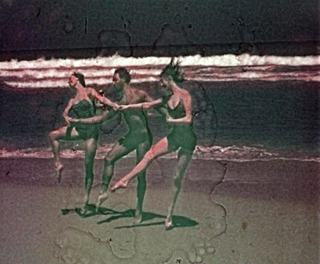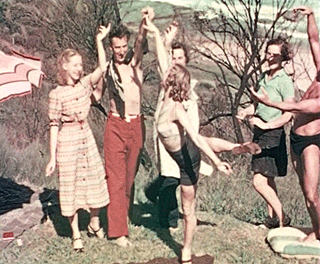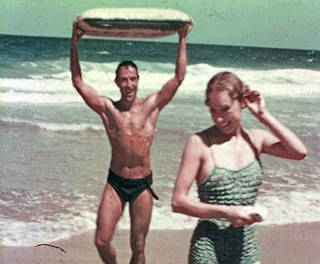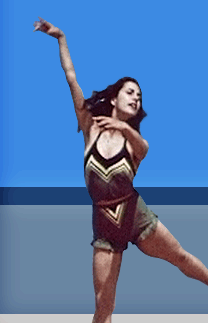
FINDING THE ARCHIVE FOOTAGE
Several years ago a friend found a trunk full of 16mm film footage
in the junky space beneath his families house in the Blue Mountains,
New South Wales, Australia. Much of the film was too damaged to
repair but around three hours survive, some covered in a beautiful
vinegary texture. The rest, both black and white and colour, is
clear and well preserved. It is almost exclusively home movies
of dancers from the Ballets Russes.
 |
The Ballets Russes toured Australia for the first time in 1936
and again in 1938/9, 1939/40. An amateur cameraman, Ewan Murray-Wills,
in real life a Sydney dermatologist, filmed several of the Ballet’s
leading soloists - unguarded moments, dancing on the beach, picnics
and visits to the zoo as well as many different scenes from stage
performances. He often used early 16m-colour reversal stock, sometimes
experimenting with slow motion. The dancers move loosely for their
friend behind the camera, often smiling directly at him. They
are without the traditional heavy make up and costumes we expect
from classical ballet. Hair flies all over the place. They frolic
in their swimwear, playing and laughing. The beach and sea give
them an energy and life that is quite different from a stage performance.
We see a group of young people having fun with a new toy. The
scale of the beach allows them to run and leap with immense freedom.
Behind them the sea swells and breaks in slow motion. One man
in particular smiles a little too often at the man behind the
camera
Tiny figures of other bathers occasionally flit across the sand
or bob in the surf. To dance on sand is not easy. The myth of
the Ballets Russes is enormous. Here we see the energy of the
dancers but also a carelessness in their technique, which we don’t
expect.
 |
 |
BACKGROUND - THE BALLETS RUSSES
The early years of the Ballets Russes under Diaghilev and in the
days of Nijinsky are the best known. The company started in 1909.
After Diaghilev’s death the company went through various
crisis and splits appearing under different titles.
The footage I am concerned with is from De Basil’s Ballets
Russes, a company that ran from 1931 –1952.
DE BASIL’S BALLETS RUSSES by Katherine Sorley Walker
provides a detailed history of this branch and period of the Ballets
Russes
Other names of the de Basil Ballets Russes are the Montecarlo
Russian Ballet and the Original Ballets Russes. And there are
more, as the complications of finance and legal actions meant
forming and reforming, dancers going from one company to another.
The Ballets Russes, in all it’s forms, and many of its dancers
have acquired mythical status. Descriptions of their performances
have been handed down. We can rarely see them and by seeing them
verify them. There is performance footage of the de Basil Ballets
Russes shot by another surgeon in Australia, Joseph Ringland Anderson.
This footage has been in the public domain for many years.
The Ewan Murray Wills footage surfaced only 10 years ago and is
now in an archive in Canberra. There is a lot of history and useful
detail about the Ballet Russe, tours, profiles of the dancers
and photos on their website www.australiadancing.org
 |
The performances on my footage are rough, full of energy, youthful
and passionate. There is emotion and sometimes silent screen type
gesture and exaggeration that we see less often now. The women
are strong and rounded. No hint of anorexia here.
Before I knew the identity of any individual dancers I showed
some of the film to Bill Forsyth ( leading contemporary choreographer)
and Dana Kasperson ( leading contemporary dancer) They were delighted
and entertained by it. They thought the dancers must be corps
de ballet at the most. It turned out later that all the dancers
I’d showed them were soloists, among them one or two of
the Ballet’s most prestigious ballerina’s.
The dancers were dancing on sand which would account for some
of their technical difficulties but I think it also shows that
expectations of dance technique has changed considerably, as has
the preferred shape of a female ballet dancer. In spite of this,
the film offers up some exhilarating and beautiful moments.
I decided to try and trace any of the dancers who were still alive,
to talk to them and show them the footage.
THE FILM I THOUGHT I WANTED TO MAKE
I had just finished a film for the BBC called ALBUM in which I
traced the descendants of the owner of an old photo album dating
from 1900 that I’d bought from a secondhand bookstall in
Farringdon Road, London in the late 1960’s.
My Australian friends saw ALBUM and imagined a similar journey
using the Ballets Russes footage. I loved the idea, loved the
archive and have had a long association with dance.
Who are they? Where are they? What are they doing now?
I would find the dancers, show them the footage, listen
to their stories and film all of this along with showing what
they do now in their later years. I would ask how they now see
their younger dancing selves.
So I started the research.
I found a few of them and talked to them, scattered round the
world in the UK, Brazil, Australia and the US.
|








